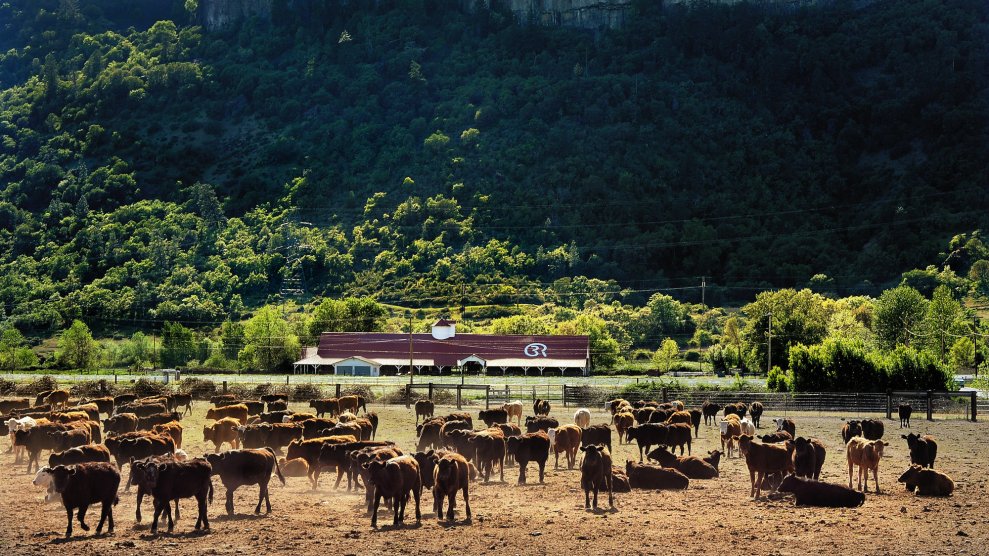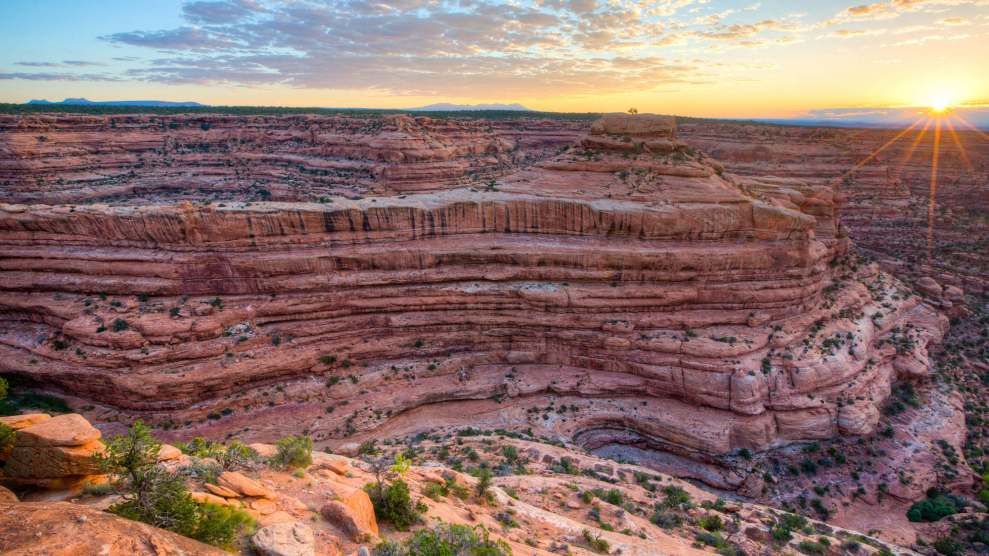
Bob Pennell/Mail Tribune/AP
This story was originally published by High Country News and appears here as part of the Climate Desk collaboration.
The smell of scorched soil and burnt wood filled the air. Michael Rondeau, CEO of the Cow Creek Band of Umpqua Tribe of Indians, looked over the damage, clad in forest-green pants and a lemon-yellow jacket with “Douglas Forest Patrol” on the back. The Milepost 97 Fire, which started just days earlier with an illegal campfire, had consumed almost 13,000 acres in southwest Oregon. Almost a quarter of that was on the Cow Creek Band of Umpqua Tribe of Indians Reservation—land so recently acquired by the tribe from the Bureau of Land Management that no conservation work or logging had yet occurred.
The tribe lost a good stand of timber, and officials estimate that replanting and recovery could take millions of dollars. Less than two months earlier, I had visited this tract of land, touring it with Rondeau and Tim Vredenburg, Cow Creek director of forest management. Then, it had been lush with evergreens and wildflowers—lupine, beargrass and paintbrush. Now, that was all gone.
“We’ve been so focused on managing to prevent fire,” Vredenburg told me over the phone, a few days after the fire. “That’s where all of our mental energy was being invested in: How do we manage this forest to prevent fire? And doggone it, now we’re looking at: How do we manage it after fire?”
The answer may lie in something Vredenburg and Rondeau said to me before the fire: that the Cow Creek lands would be managed differently now than they were by US agencies prior to their return. Thinning and reintroducing fire through prescribed burns, they told me, would be a top priority for the more than 17,000 forested acres the tribe received through the Western Oregon Tribal Fairness Act in 2018. Rondeau explained that the management of Cow Creek Band of Umpqua Tribe of Indians reservation lands would reflect Indigenous values: an example separate from either industry or conservation groups. “We don’t believe in locking up the forests and allowing them to ‘remain natural,’ because it never was,'” Rondeau said. “For thousands of years, our ancestors used fire as a tool of keeping underbrush down, so that the vegetation remains healthy and productive.”
Looking down from Canyon Mountain at a valley full of blackened madrones and pines, Rondeau and Vredenburg—along with some 1,800 Cow Creek tribal citizens—are thinking of the future, 165 years after their lands were taken and only one year after they were partially returned. The Western Oregon Tribal Fairness Act’s passage illustrates just how long it can take—and the kind of political will it can require—to hold the United States and its citizens accountable for illegal treaty violations.
The journey to regain control of Cow Creek lands has been a long one. In 1853, six years before the state of Oregon existed, the Cow Creek Band of Umpqua Tribe of Indians signed a treaty with the US government. In exchange for a reservation, housing and health care, the Cow Creek ceded 800 square miles of land. But instead of complying with the terms of its treaty, the federal government sold Cow Creek lands to settlers through the Donation Lands Claim act, making the tribe landless. In 1932, Congress passed a bill to restore the tribe’s land base, only to see it vetoed by President Herbert Hoover. Litigation followed. “That really did set back our tribal members for quite a few decades,” Rondeau says. “There was a continuation of their lifeways, but the longer it went from the time of the treaty, they would lose more and more of their culture or just simply be blended in to the new life ways and assimilate.”
But last year, the Cow Creek made a breakthrough with the Western Oregon Tribal Fairness Act. The act—which passed the US House seven times, only to die each time in the Senate—finally was signed into law by President Donald Trump. It restored more than 17,000 acres of public land to the Cow Creek Band, along with nearly 15,000 acres to the Confederated Tribes of Coos, Lower Umpqua and Siuslaw Indians.
“This is pretty rare. It shouldn’t be, but it is,” says Cris Stainbrook, president of the Indian Land Tenure Foundation, of the restoration act. “Those are the homelands of the tribe—these are lands that were reserved by the tribe in the treaty process.”
The Milepost 97 fire, then, was particularly devastating as a pointed reminder of the tribe’s long pursuit of land. During the Termination Era, which started in 1954 and affected tribal nations across the US, the federal government terminated 61 western Oregon tribes, abdicating its legal responsibility to Indigenous communities. (To date, five tribes in western Oregon have regained their federal status.) In the 1950s, former Oregon Gov. Douglas McKay, who headed the Interior Department, “enthusiastically” supported termination, after pushing state-level policies to “integrate the Indians into the rest of our population.”
Michael Rondeau represents one of the last generations of Cow Creek to remember what termination was like: no access to higher education or health care, and no land base—despite legal promises. His father, Tom Rondeau, the descendant of French traders and Umpqua people, grew up with a ramble of cousins on his grandparents’ Tiller, Oregon, homestead in the 1940s, hearing a mix of English, French and Chinuk Wawa, also known as Chinook Jargon. Tom, a big guy with a flattop, raised Michael and his brother in Glide, Oregon—17 miles from where Michael now lives and works. The Rondeaus were a timber family, and Michael spent his childhood summers on the meandering North Umpqua River, a self-proclaimed river rat. By age 17, his dad had him setting chokers on Douglas fir trees to make sure he understood the hard labor he’d be doing if he chose to work in the timber industry.
Decades after termination, persistent efforts by tribal nations and advocates resulted in the federal government once again recognizing tribes and treaty obligations. In the 1970s and ’80s, the Confederated Tribes of Siletz Indians and the Confederated Tribes of Grand Ronde gained federal recognition again, along with some lands. The Coquille Indian Tribe, Cow Creek and Coos were re-recognized, too, but without lands. Efforts by tribes in what is currently western Oregon to reacquire their land came shortly after recognition.
In 1996, the Coquille Indian Tribe, based on Oregon’s southern coast, regained 5,400 acres of BLM land. But local voters opposed the transfer by nearly 5 to 1 in an advisory vote, and the final legislation required that the tribe allow public access for hunting, recreation and fishing.
An attempt by the Confederated Tribes of Coos, Lower Umpqua and Siuslaw Indians to acquire federal lands the next year in 1997 hit a roadblock when voters and environmental groups vocally opposed the transfer, arguing that the land would no longer be subject to federal environmental law, despite promises from the tribal chairman that the tribe would adhere to federal standards. “Although the Coos tribe still hasn’t formulated details such as the amount of acreage or specific parcels of land,” a 1997 Associated Press article wrote, “environmentalists already say they would oppose any plan that would remove federal land from public control.” The Coos tribe would not receive their lands for another 21 years, until the Western Oregon Tribal Fairness Act.
In 2013, when the Cow Creek drew up plans for the BLM land transfer, Oregon Sen. Ron Wyden’s office nixed the deal. The lands were ground zero for the timber wars of the 1990s, when the Endangered Species Act and industry clashed over the spotted owl, making their transfer almost 20 years later a non-starter for conservation groups. “It was such a touchy conversation with the environmental community—it would have been a complication that would have been hard to overcome,” Rondeau said. Instead, the tribe received BLM lands of relatively lower timber quality—checker-boarded lands, instead of the contiguous land base of many reservations.
The tribe also tried a less conventional approach. In 2017, the Cow Creek Tribe made a bid to buy Elliott State Forest, after the state of Oregon put it up for sale. The Elliott, which was legally required to make money for Oregon schools, hadn’t been producing enough. “Our tribal leadership was concerned that some out-of-state, out-of-the-area or foreign-owned company could come in and buy this forest,” Vredenburg said. With its $220 million price tag, the Elliott was out of reach, so the Cow Creek turned to Lone Rock Resources, a local Oregon-based timber company.
Conservation groups, critical of Lone Creek’s forestry practices, staunchly opposed its involvement and accused the partnership of wanting to privatize the forest. Conservationists in turn were called out for their failure to work with tribal nations: “Your organization has mobilized opposition to the sale, with little to no engagement with the Tribes who would have, once again, become the stewards of this land,” a consortium of racial justice groups, including NAACP Portland, wrote in an open letter to the Sierra Club, Cascadia Wildlands and four other conservation organizations. “We also note the many ways in which environmental groups in Oregon remain predominantly white, and work from a place of white privilege; this situation is a very clear example of the lack of racial justice analysis applied to what is a complicated situation.” Then-Sierra Club Oregon Chapter Director Erica Stock responded, “As an environmental conservation community, we must do more to proactively reach out to Tribal Nations and rebuild trust.”
Ultimately, the sale was dropped by the state after intense public outcry, but tensions between conservation groups and tribes remain.
“The conservation movement began as a way for settlers to justify the seizure of Indigenous lands under the pretext that Native peoples didn’t know how to manage them,” says Shawn Fleek, Northern Arapaho, who is director of narrative strategy for OPAL Environmental Justice Oregon. “If modern conservation groups don’t begin their analysis in this history and struggle to address these harms, it becomes more likely they will repeat them.”
Rhett Lawrence, conservation director for the Sierra Club’s Oregon chapter, says that his group opposed the timber company and privatization, not the concept of tribes regaining their lands. Still, Lawrence acknowledges, “We need to do better about having those conversations. We certainly have not resolved things from where they were two years ago.” Since then, two groups named in the open letter, Trout Unlimited and Wild Salmon Center, have now partnered with the Cow Creek Tribe on restoration projects.
Once a decade, a national study of tribal forests is conducted to monitor land health, production and management. The latest study, in 2013, found that the federal government was not fulfilling its trust responsibility to fund tribal forestry programs, yet noted that tribal stewardship could nonetheless serve as a model for resource management and practices on federal lands. “Those studies have shown that Indian forest management is superior than BLM and BIA because of the direct tie the Indian people have to the land,” says George Smith, chief forester for the Bureau of Indian Affairs from 1978 to 1983 and the former executive director for the Coquille Tribe. “That’s their homeland, so they have a lot more vested interest in how those lands are managed.”
Tribes are often better at managing timberland holistically, says Smith, adding: “The tribal capacity with most of the tribes now, particularly the self-governance tribes, is at least equal to or better than the federal government.”
On a chilly December night in 2018, Michael Rondeau learned that the Western Oregon Tribal Fairness Act had passed. He had been driving through Medford, Oregon, when the call came from Sen. Wyden’s office. After hearing the news, he sat in his car in a parking lot, feeling drained. The Cow Creek would have at least some land back, roughly 3% of what was originally ceded, the result of decades of letter-writing, lobbying, and compromising. “I was of course proud of my team, and the effort that we had accomplished. I was excited for the future and knowing what it would mean to our people,” Rondeau says now. But the sense of victory was inextricably linked with the feeling of injustice that the act sought to correct. “Probably most emotional for me was the sadness that my grandparents and great aunts and uncles and beyond that didn’t have a day of recognition.”
He thought of his great-aunt, Francis Rondeau Corder, whom they had cared for, ferrying her from her mobile home to doctors’ visits that they had to pay for out of pocket, since the promised federal medical care never materialized. She passed before the tribe was recognized. He’d seen the legislation go through the House seven times since 2012, only to die in the Senate, victim to horse-trading and the hazards of Congress.
While the Western Oregon Tribal Fairness Act received less public pushback than the land conveyances of the 1990s and the Elliott debacle, some hard-line environmentalists continue to oppose the return of public lands to tribes. Al Runte, a Seattle-based environmental historian, wrote in National Parks Traveler in January that “had we protested the Western Oregon Tribal Fairness Act, they would have called us racists.” Meanwhile Andy Kerr, who worked for two decades at Oregon Natural Resource Council (now Oregon Wild), still objects to public lands becoming tribal lands. “The Democrats who supported this legislation came down on the side of Native Americans and, in this case, against nature,” Kerr wrote in a December 2018 post on his website.
While “Native Americans” should get some form of compensation, Kerr argued that “such compensation should not come at the cost of losing federal public lands of benefit to all Americans.” Both Runte and Kerr see money as an adequate substitute despite treaty law, since “in the society that won out in that struggle for a continent, the most common way to right wrongs is by money being transferred to the aggrieved parties from the parties that unjustly benefited.” Kerr continues: “The currency of compensation by the United States to Native American tribes ought to be the currency of dollars, not that of the irreplaceable and precious public lands that belong to all of us.”
But it’s not a matter of money, says Cris Stainbrook, Oglala Lakota, of the Indian Land Tenure Foundation. “It’s ironic they don’t recognize they’ve had the public benefit of lands for on the order of 165 years of using someone’s land that was guaranteed to them, and used those lands to their own benefit. It’s about time, after 165 years, that they live up to the treaty.”
Stainbrook says he and others at the foundation often hear arguments like these against tribes working to regain land. Often, opponents say that too much time has passed—that broken treaties, while unfortunate, are a relic of the past. “The same could be said of the US Constitution—why bother with any of that, that was done in the 1770s,” Stainbrook says. “I could quit paying my house mortgage tomorrow, since I signed that nearly 20 years ago. Time isn’t the issue here.”
The Milepost 97 fire started a mile south of Canyonville, Oregon, on July 24, then spread to an old burn scar from the 1980s that was, at the time, BLM land, and is now Cow Creek again. Nine firefighters were injured over five days as snags 100 feet in front of the fire ignited from the embers, “lighting up like roman candles,” recalled Vredenburg.
Recovery from fire means different things depending on the time scale, but with the fires still burning, it’s difficult to think too far ahead. “The irony of finally, after 165 years, getting the reservation that was promised in the treaty, only to have almost a quarter of it burned, it’s gut-wrenching,” Rondeau told me from his office in early August. Still, he talks about the importance of beginning the hard work now, to be carried on for generations of Cow Creek: “I was taught that land was forever.”
The cream-colored beargrass, purple lupine and red paintbrush wildflowers will return within the next few years, and in a few decades, mature pines. But the legacy of fire and its scars will always be there, under the heights of evergreens.















